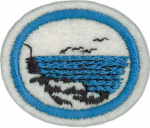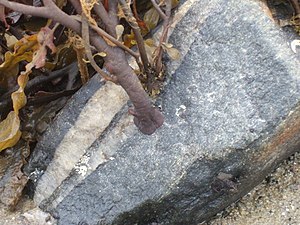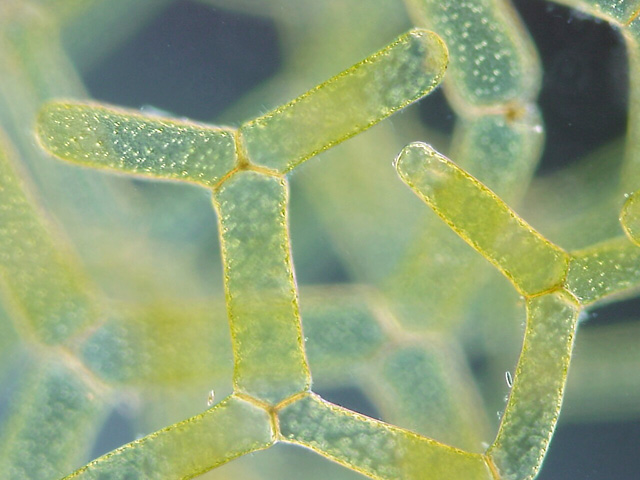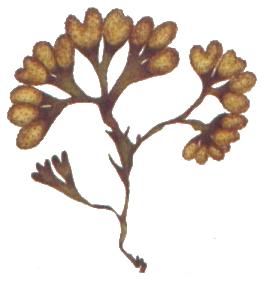Difference between revisions of "AY Honors/Marine Algae/Answer Key/es"
(Created page with "==14. Hacer una colección de al menos 20 ejemplares de algas marinas debidamente identificadas, montadas y etiquetadas. Debe haber al menos 4 especímenes del grupo de las ve...") |
(Created page with "==15. Ser capaz de identificar por nombre genérico, como mínimo, 10 clases de algas marinas.==") |
||
| Line 62: | Line 62: | ||
==14. Hacer una colección de al menos 20 ejemplares de algas marinas debidamente identificadas, montadas y etiquetadas. Debe haber al menos 4 especímenes del grupo de las verdes, 8 de las pardas y 8 de las rojas.== | ==14. Hacer una colección de al menos 20 ejemplares de algas marinas debidamente identificadas, montadas y etiquetadas. Debe haber al menos 4 especímenes del grupo de las verdes, 8 de las pardas y 8 de las rojas.== | ||
| − | ==15. | + | ==15. Ser capaz de identificar por nombre genérico, como mínimo, 10 clases de algas marinas.== |
| − | |||
| − | |||
| − | |||
| − | |||
| − | |||
| − | |||
| − | |||
| − | |||
| − | |||
| − | |||
| − | |||
| − | |||
{{Species id | {{Species id | ||
Revision as of 20:29, 6 October 2014
| Algas Marinas | ||
|---|---|---|
| Asociación General
|
Destreza: 3 Año de introducción: 1961 |
|
Requisitos
1. ¿Qué es una alga marina?
2. ¿Dónde se encuentra?
3. ¿Cómo se llama el órgano de acoplamiento para el sustrato? ¿Cómo difieren de una raíz verdadera?
4. ¿Cómo varían en tamaño las algas marinas?
5. Nombrar los 4 grupos de algas marinas, indicando junto al nombre de cada grupo si es unicelular, multicelular o ambas.
| Group | Unicellular | Multicellular |
|---|---|---|
| Red Algae | ||
| Brown Algae | ||
| Green Algae | ||
| Diatoms |
6. ¿En dónde se encuentran más algas verdes, en agua dulce o salada?
7. ¿Qué son diatomeas?
Las diatomeas son un grupo amplio y se pueden encontrar en los océanos, en agua dulce, en la tierra y en las superficies húmedas. La mayoría viven en aguas abiertas, aunque algunos viven en las capas superficiales de la interfase agua-sedimento, o incluso en condiciones atmosféricas húmedas. Son especialmente importantes en los océanos, donde se estima que contribuyen hasta un 45% de la base de la cadena alimentaria oceánica.
8. ¿Dónde crecen las algas más fácil: en las zonas polares, templadas o tropicales?
9. ¿Dónde se encuentran la mayoría de las algas pardas invariablemente, en agua dulce o salada?
Las algas pardas se encuentran en la mayoría de los ecosistemas de agua salada.
10. ¿Cuál es la mayor profundidad en los océanos donde las algas crecen? ¿Por qué no puede crecer en agua más profunda?
La algas que viven en lo más profundo son aquellos que están unidos a los fondos marinos bajo varios metros de agua. El factor limitante en estos casos es la disponibilidad de suficiente luz solar para apoyar la fotosíntesis. Las algas que viven en lo más profundo son las diversas algas pardas.
11. Nombrar las 3 partes de las grandes algas pardas (kelp). ¿Cómo se comparan ellas con la hoja, tallo y raíz de una planta?
- Blade
- The blade is a large, flat structure, and is analogous to a plant's leaves.
- Stipe
- The stipe serves as a stem to which the blades are attached.
- Holdfast
- The holdfast is the part of the plant that anchors it to a substrate, such as a rock or the seafloor. It is analogous to a plant's root.
12. Describir las 2 maneras en que se reproducen las algas.
Reproducción Sexual
La mayoría de las formas de algas se reproducen sexualmente mediante la formación de esporas. Las esporas, cuando se desechan el organismo adulto, se convierten en gametos masculinos y femeninos que llevan sólo la mitad de la información genética del organismo progenitor. Estos gametos son móviles, lo que significa que pueden moverse por sí mismos, propulsados por pequeños flagelos. Cuando los gametos masculinos y femeninos de la misma o de diferentes organismos parientes combinan, el material genético se fusiona para crear un organismo con un complemento completo de material genético. Esto es muy similar a la forma en que se reproducen los helechos (véase la especialidad Ferns para más detalles).
Reproducción Asexual
La reproducción asexual es ventajoso ya que permite aumentos de la población eficientes, pero menos variación es posible. La reproducción sexual permite más variación pero es más costosa debido a la pérdida de gametos que fallan para aparearse, entre otras cosas. A menudo no hay alternancia estricta entre las fases esporofito y gametofito y también porque a menudo hay una fase asexual, que podría incluir la fragmentación del talo.
13. ¿Cuáles son algunos de los valores comerciales de las algas? Mencionar al menos uno por cada grupo.
14. Hacer una colección de al menos 20 ejemplares de algas marinas debidamente identificadas, montadas y etiquetadas. Debe haber al menos 4 especímenes del grupo de las verdes, 8 de las pardas y 8 de las rojas.
15. Ser capaz de identificar por nombre genérico, como mínimo, 10 clases de algas marinas.
Deadman's Fingers (Codium)
Descripción: The genus has thalli of two forms, either erect or prostrate. The erect plants are dichotomously branched to 40 cm long with branches forming a compact spongy structure, not calcareous. The final branches form a surface layer of close palisade cortex of utricles. The non-erect species form either a prostrate or globular thallus with a velvet-like surface, the final branches forming a close cortex of utricles.
Water Net (Hydrodictyon reticulatum)
Descripción: The name water net comes from its shape, which looks like a netlike hollow sack. It can grow up to several decimeters.
Pediastrum (Pediastrum simplex)
Descripción: The name Pediastrum means "plain star", because this alga is very much star-shaped. It can be found in many ponds, making the water appear greenish.
Volvox aureus (Volvox aureus)
Dónde se encuentra: Volvox is found in ponds and ditches, and even in shallow puddles. The most favorable place to look for it is in the deeper ponds, lagoons, and ditches which receive an abundance of rain water. It has been said that where you find Lemna, you are likely to find Volvox; and it is true that such water is favorable, but the shading is unfavorable.
Descripción: Volvox is one of the best-known chlorophytes and is the most developed in a series of genera that form spherical colonies. Each Volvox is composed of numerous flagellate cells similar to Chlamydomonas, on the order of 1000-3000 in total, interconnected and arranged in a glucoprotein filled sphere (coenobium). The cells swim in a coordinated fashion, with a distinct anterior and posterior - or since Volvox resembles a little planet, a 'north and south' pole. The cells have eyespots, more developed near the anterior, which enables the colony to swim towards light.
Brown Algae
Fensholt (Sargassum muticum)
Descripción: Sargassum muticum is a large brown seaweed of the Division Phaeophyta. It grows attached to rocks by a perennial holdfast up to 5 cm in diameter. From this holdfast the main axis grows to a maximum of 5 cm high. The leaf-like laminae and primary lateral branches grow from this stipe. In warm waters it can grow to 12 m long, however in British waters it grows to no more than 4 m long. The holdfast gives rise to a single main axis with secondary and tertiary branches which are shed annually. Numerous small 2-6 mm stalked air vesicules provide buoyancy. The reproductive receptacles are also stalked and develop in the axils of leafy laminae. It is self fertile.
Kelp (Macrocystis)
Descripción: Macrocystis is a genus of kelp, some species of which are so huge that the plants may grow to up to 60m. The stipes arise from a holdfast and branch three or four times from near the base. Blades develop at irregular intervals along the stipe. M. pyrifera grows to over 45 m long. The stipes are unbranched and each has a gas bladder at its base.
Peacocks tail (Padina pavonica)
Descripción: Padina pavonica, commonly known as Peacocks tail, is a brown alga found in Atlantic Ocean. It is known to act as an elastin precursor when applied topically, signaling collagen production in the skin, thereby increasing the skin's elasticity.
Spiral wrack, Flat wrack (Fucus spiralis)
Descripción: Fucus spiralis is olive brown in color and similar to Fucus vesiculosus and Fucus serratus. It grows to about 30 cm long and branches somewhat irregularly. It attached by a discoid holdfast. The flattened blade has a distinct midrib and is usually spirally twisted without a serrated edge, as are to be seen in Fucus serratus, and it does not show air-vesicles, as is Fucus vesiculosus.
Bladder wrack (Fucus vesiculosus)
Dónde se encuentra: Fucus vesiculosus is one of the most common algae on the shores of the British Isles. It is recorded from the Atlantic shores of Europe, the Baltic Sea, Greenland, Azores, Canary Islands and Madeira. It also appears on the Atlantic coast of North America from Ellesmere Island, Hudson Bay to North Carolina.
Descripción: Fucus vesiculosus is a very variable alga. It can grow to 100 cm or more and is easily recognized by the small gas–filled vesicles which occur in pairs on either side of a central midrib running along the center of the strap-like frond. It was the original source of iodine, discovered in 1811, and was used extensively to treat goiter, a swelling of the thyroid gland related to iodine deficiency. A common food in Japan, bladder wrack is used as an additive and flavouring in various food products in Europe. Bladder wrack is commonly found as a component of kelp tablets or powders used as nutritional supplements. It is sometimes loosely called "kelp", but that term technically refers to a different seaweed.
Toothed wrack, Serrated wrack (Fucus serratus)
Descripción: Fucus serratus is a seaweed of the north Atlantic Ocean, known as toothed wrack or serrated wrack. It is olive–brown and similar to F. vesiculosus and Fucus spiralis. It grows from a discoid holdfast. The fronds are flat, about 2 cm wide, bifurcating, and up to 1 m long including a short stipe. The flattened blade has a distinct midrib and is readily distinguished from related taxa by the serrated edge of the fronds. It does not have air vesicles, such as are found in F. vesiculosus, nor is it spirally twisted like F. spiralis.

Two fronds of Laminaria digitata washed up on the foreshore of Anglesey, Wales, UK; background is mostly Ascophyllum nodosum. Ascophyllum nodosum
Knotted wrack, Egg wrack (Ascophyllum nodosum)
Dónde se encuentra: It is common on the northwestern coast of Europe (from Svalbard to Portugal) including east Greenland [1] and the northeastern coast of North America.
Descripción: Ascophyllum nodosum is an edible seaweed of the northern Atlantic Ocean. Ascophyllum nodosum has long fronds with large egg-shaped air-bladders set in the fronds at regular intervals and not stalked. The fronds can reach 2 m in length. They are attached by a holdfast to rocks and boulders. The fronds are olive-brown in color and somewhat compressed but without a mid-rib. This seaweed grows quite slowly and can live for several decades; it may take approximately five years before becoming fertile.
Red Algae
Irish moss (Chondrus crispus)
Dónde se encuentra: Chondrus crispus grows abundantly along the rocky parts of the Atlantic coast of Europe and North America. It can also be found in the Northern Pacific Ocean and parts of the Mediterranean.
Descripción: Chondrus crispus is a relatively small red algae little more than 20cms long growing from a discoid holdfast and branching in a dichotomous, fan-like, manner four or five times. The morphology is very variable, especially the broadness of the thalli. The branches are 2 - 15 mm broad, firm in texture and dark reddish brown in color bleaching to yellowish in sunlight. In its fresh condition the plant is soft and cartilaginous, varying in color from a greenish-yellow to a dark purple or purplish-brown; but when washed and sun-dried for preservation it has a yellowish translucent horn-like aspect and consistency. The principal constituent of Irish moss is a mucilaginous body, of which it contains about 55%; the plant also has nearly 10% of protein and about 15% of mineral matter, and is rich in iodine and sulphur. When softened in water it has a sea-like odour, and because of the abundant mucilage it will form a jelly when boiled, containing from 20 to 30 times its weight of water. Irish moss is a major source of carrageenan, which is commonly used as a thickener and stabilizer in milk products such as ice cream and processed foods.
Nori (Porphyra)
Descripción: Porphyra is a foliose red algal genus of laver, comprising approximately 70 species. It grows in the intertidal, typically between the upper intertidal to the splash zone. In East Asia, is used to produce the sea vegetable products nori (in Japan) and gim (in Korea), the most commonly eaten seaweed. It is considered that there are 60 to 70 species of Porphyra worldwide and seven in the British Isles.
References
- Seaweed Lady on Flickr has many photos of various seaweeds.
- http://www.csd509j.net/cvhs/berand/Marine2007-2008/Labs/Student%20Pressing%20Algae%20Lab.doc - information on drying and mounting algae
- Categoría: Tiene imagen de insignia
- Adventist Youth Honors Answer Book/Honors/es
- Adventist Youth Honors Answer Book/es
- Adventist Youth Honors Answer Book/Skill Level 3/es
- Categoría: Libro de respuestas de especialidades JA/Especialidades introducidas en 1961
- Adventist Youth Honors Answer Book/General Conference/es
- Adventist Youth Honors Answer Book/Unknown/es
- Adventist Youth Honors Answer Book/Unknown/Primary/es
- Adventist Youth Honors Answer Book/Stage 0/es
- Categoría:Especialidades JA/Identificación de especie
- Adventist Youth Honors Answer Book/Completed Honors














